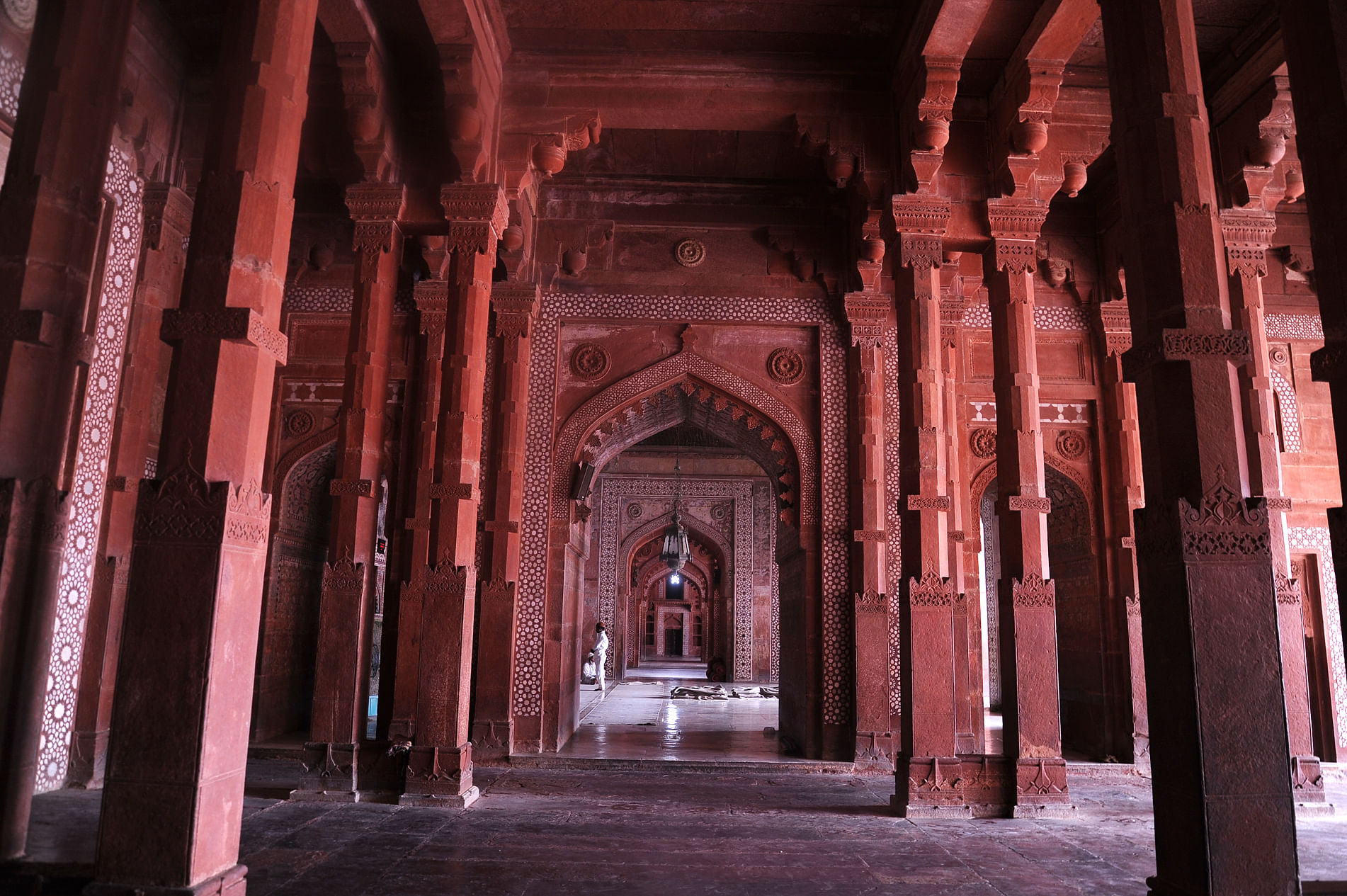
Early mornings are best for visiting heritage monuments. This is the time when they are free from noise-making touts and tourists. You can listen to the music of stones as they narrate accounts of history. When we alighted in Fatehpur Sikri on a fine winter morning, it was draped in fog, and thin layers of mist were rising, revealing the red sandstone palaces behind them.
Fatehpur Sikri is a site of antiquity. Its history is dotted with names of Sikarwar Rajputs (12th century), Timur (1398-99), Mubarak Shah (1421-1434), Sikandar Lodhi (1489-1517), Ibrahim Lodhi (1517-1526) and Babar. But the city owes much of its existence to a Muslim Sufi saint, Sheikh Salim Chishti, who settled on its barren ridge in 1564. Emperor Akbar sought his blessings. The saint foretold the birth of an heir. Akbar’s queen gave birth to a son on August 30, 1569 in Rang Mahal Palace and the newborn was named as Salim, after the name of the saint.
As a token of gratitude, Akbar built the Jami Masjid for the saint in 1571 and ordered the construction of splendid palaces. He did not disturb the capital status of Agra, but shifted his residence and court to Sikri, and founded all-Mughal institutions — like Ibadat Khana, Din-i-Ilahi and Jharokha Darshan — even as the construction of palaces continued between 1572 and 1585. Thus came into existence a masterpiece in red sandstone, the first planned city and the cultural capital of the Mughals. Akbar renamed the village as Fatehabad, but it became popular as Fatehpur (City of Victory) in due course.
But first, food
We treated ourselves to jalebi, kachori and a cup of hot tea, and went to explore the monuments. We were the first visitors to the palace complex, so we had ample time for photographing the Diwan-i-Khas (Jewel House), a square building of red sandstone, whose striking feature is a massive red sandstone column rising from the centre of the hall. Its column is square at the base, octagonal at the shaft, and takes a 16-sided form near the capital, then a circular form, and further above, branches out into 36 three-tier brackets that support a circular platform.
There are as many legends in Fatehpur Sikri as there are relics. The Anup Talao (Peerless Pool) was once filled with coins of gold, silver and copper, and the emperor distributed the wealth. It has a masonry tank with a square island platform placed in its centre. Stone bridges, supported by stone columns with bracket capitals, radiate from its central platform and connect to the sides of the tank. It is said that Tansen, one of the ‘nine gems’ of the Mughal court, sang his ragas from the central platform of Anup Talao.
Akbar used to present himself before his audience from Panch Mahal, a large pyramidal building of five storeys. Starting from the ground floor, its successive storeys have 84, 56, 20 and 12 pillars, and the uppermost storey is crowned with a beautiful chhatri with four pillars. The total number of pillars in the building adds up to 176, and no two of them are alike.
Elephant fights, hunting, battles, and Indian flora & fauna have been depicted in Mariyam Palace (Sunehra Makan) where Akbar received his painters and artists from many states. Renowned calligraphers of Mughal court painted the Persian verses of poet Faizi there. It also has carved decorations of rows of elephants and swans.
Minutes later, we entered the magnificent Jami Masjid (Friday Mosque) Complex through the Royal Gate and a vista of beauty opened before our eyes. This red sandstone mosque, completed in 1571, is a gem of Mughal architecture. The façade of its sanctuary is composed of a portal and an arcade on its either side. The broad chhajja, supported on beautiful brackets and a series of chhatris above the parapet, one over each pillar, makes a graceful work of art. The central compartment (nave) of the prayer hall is roofed by a huge dome and flanked on either side by one small dome.
All niches (mihrabs) and arches of the prayer hall are ornamented with a fringe of lotus buds. The sheer brilliance of Quranic and Persian verses, floral and geometrical patterns, carved, inlaid and painted in many colours add their beauty to this masterpiece.
Pious activities
There was a steady stream of pilgrims at the marble mausoleum shrine of Sheikh Salim. Some qawwals were singing in praise of the saint. The verandah around his tomb is closed on all sides by intricate perforated screens that carry star and swastika designs. We spent some time in the shrine and saw the sun painting its own chiaroscuro in the verandah through the jalied (perforated) screens.
Akbar replaced the old southern entrance of the mosque with the Buland Darwaza, a lofty portal facing south (Deccan), after his successful campaign in the Deccan region in 1601. It’s ranked among one of the largest gateways of the world. Once deserted by Akbar, Fatehpur Sikri could never regain its lost glory. Akbar’s son Jehangir (Salim) stayed here for a few months when the plague raged in Agra in 1619. A century later, Muhammad Shah Rangeela was crowned here.
Down the road, our bus to Agra was about to depart. We stood before the Buland Darwaza for one long and deep look, as if to chisel its image in our hearts.